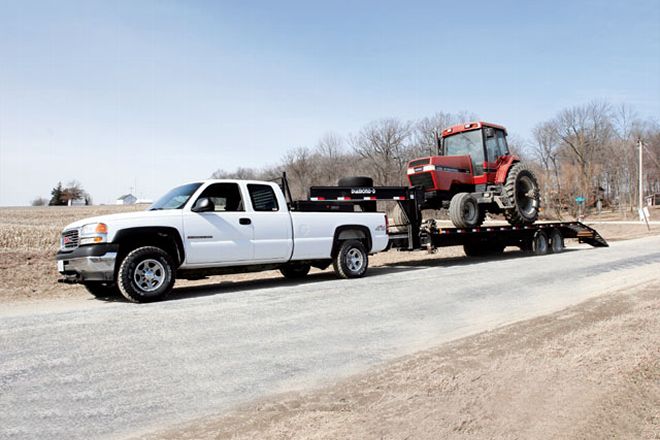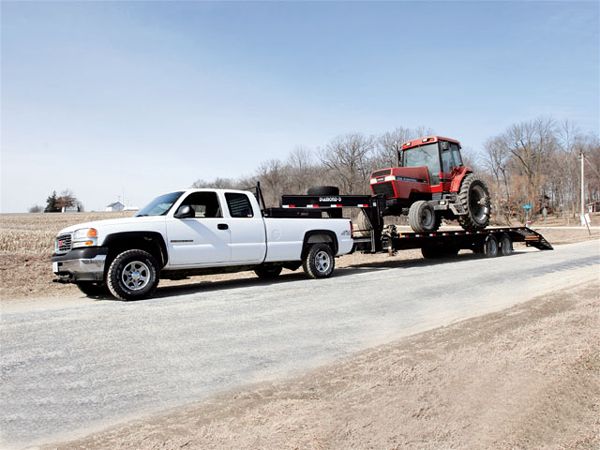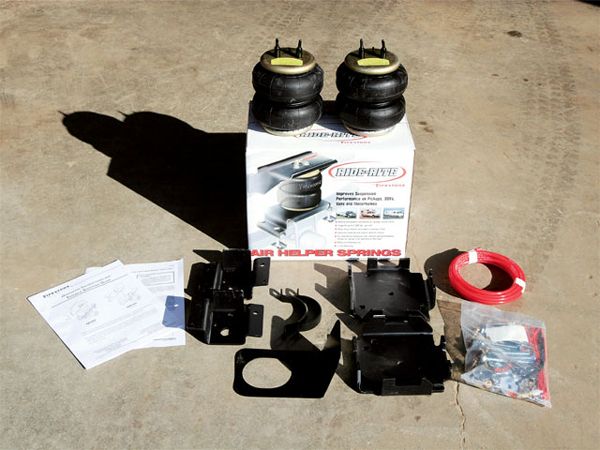
 Ken Brubaker
Senior Editor, Four Wheeler
Ken Brubaker
Senior Editor, Four Wheeler

Imagine walking around with something heavy-like a 500-piece tool set-strapped to your back. In short order you'd have a pretty good idea of the stresses your rig's rear suspension endures when you hitch up your heavy trailer. As you walked around hunched over, it wouldn't be long before you were saying, "How about a little help here?"
Since your leaf-spring suspension can't talk, it can only convey its displeasure at being overworked by exhibiting crappy stability, bottoming out, and sometimes even breaking. There are several options for remedying this problem, but in this story we're going to shine the spotlight on airbag helper springs.
Our '02 GMC 2500 HD is a pack mule in every sense of the word and it's used to pull heavy trailers on an almost-daily basis. Thus, we wanted something that was very effective in helping the suspension weather even the heaviest tongue weights, but we wanted it to be transparent the rest of the time. We chose a Firestone Ride Rite airbag kit. Quite simply, the kit uses air helper springs positioned between the axle and frame to provide load support through the use of air pressure. We procured ours from Suspension Connection, a mail-order/e-commerce company that specializes in all things suspension-related. They offer airbag kits for a variety of vehicles, and many require no drilling to install. Not only was our kit inexpensive at less than $250, it was also shockingly simple to install. Not only was the installation and price point palatable, but as you can see in the sidebar, the results were too.

Here you can see everything contained in the Ride Rite kit for the '01-'06 Chevy/GMC 2500/3500 HD 4WD and 2WD pickup trucks. The kit includes two Firestone double convoluted air springs, upper and lower mounting brackets, a pair of bracket clamps, inflation valves, air-line tubing, a heat shield, nylon tie-wraps, all hardware, and instructions. Following are the steps for the passenger-side airbag installation; the procedure for installing the driver-side air spring is almost an exact duplicate.
With the air springs inflated to their minimum pressure of 5 psi, they simply act as jounce bumpers but do not change the height of the rear suspension. Further, we detected little if any change in ride quality or handling at this pressure, which is exactly what we wanted. The big change came when we inflated the Ride Rite airbags to their maximum pressure of 100 psi and hitched up our heavy dual-axle 5th-wheel trailer with a Case International Magnum 7110 tractor perched on the back. Before we installed the airbags, this hefty combination caused our truck's stock suspension to compress substantially, resulting in a rear bumper-to-ground measurement of 16 inches. This reflects a 7-inch drop from the stock ride height. After the airbag install, with 100 psi in the bags, that measurement increased by 5 inches to 21 inches. With the bags inflated to 80 psi, the measurement was 19.25 inches. At 50 psi, the measurement was 18.25 inches. Clearly, this is an extreme example using very heavy weight. For those of you who tow trailers with more normal tongue weights, here's another example: With just our relatively heavy 5th-wheel trailer connected, our 2500 HD's rear bumper-to-ground height dropped by 2.75 inches without the air springs installed. With 100 psi in the air springs, the rear bumper height actually increased by almost 2 inches.
Bottom line: We found that by inflating the airbags to 65 psi, we could retain the stock bumper-to-ground height with our 5th-wheel trailer hitched to our truck. When towing, we found that the airbags helped to improve the vehicle's stability too. We also found that inflating the bags to 20 psi when the vehicle is empty seems to smooth the ride of the rear suspension in everyday driving. Naturally, the air springs will also come in handy when hauling heavy cargo in the bed.






